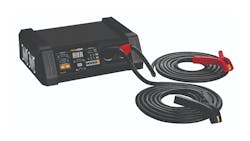Clore Automotive releases new 12/24V 120A HD Battery Charger
Clore Automotive has introduced its new PRO-LOGIX PL6850 12/24V 120A HD Battery Charger and Flashing Power Supply. The device can offer service battery charging capabilities for a range of applications, from small vehicle batteries to Group 31 multi-battery packs. It can also offer stable power to a vehicle’s electrical system during module reprogramming, ADAS calibration, electronic repairs, and other diagnostic tasks.
The system works in two different modes: charge mode and power supply mode.
Charge mode automatically charges each battery or battery pack according to its needs, whether the battery is Conventional, AGM, Spiral Wound, Start-Stop, Deep Cycle, or Marine lead acid batteries, or even LiFePO4 (LFP) Lithium batteries. The 12-volt mode provides 120/60/40/10A charging, while the 24-volt mode provides 60/40/10A, with both able to provide the charger’s highest power rating for an unlimited amount of time. Additionally, the charger includes a soft-start mode for deeply discharged batteries and a battery-repair mode for older or damaged batteries. It can even work on entirely dead batteries using a forced-start mode.
Meanwhile, the power supply mode not only maintains electrical system power during service based on a technician’s setting, but it can respond to system load increases as well. It also features a voltage output range of 13.1-14.9V (12V) or 26.1-29.8V (24V), which is adjustable in 0.1V increments.
Finally, the system’s hardware features include a detachable and field-replaceable input cable and output leads. The #2 AWG output leads are 13’ long, and the unit includes a handle for easy transport.
